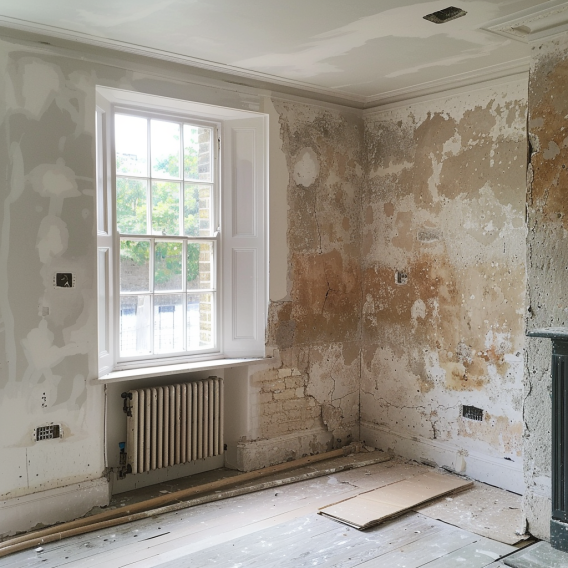Victorian-era buildings commonly used several types of materials for damp-proof courses (DPCs) to prevent rising damp:
– Bitumen felt: Layers of organic or synthetic fibres impregnated with bitumen, laid horizontally at the base of walls.
– Slate: Thin slates are laid horizontally to create a moisture barrier. This is seen from time to time in the North of Spain and is very effective when not damaged. It was also used on the lower part of the outside walls to stop rainwater from penetrating under lime.
– Engineering bricks: Dense, impermeable bricks designed for damp-proofing, laid in mortar beds at wall bases.
– Lead or copper sheeting: Durable and corrosion-resistant materials used as DPCs.
– Terracotta or ceramic courses: Laid horizontally at wall bases to prevent rising dampness.
These traditional materials were chosen for their effectiveness in preventing moisture from rising through walls. While modern methods have evolved, these materials are still found in many historic structures.
Common modern damp-proofing methods include:
– Damp-proof courses (DPC): Horizontal barriers of bitumen felt, engineering bricks, or plastic membranes installed at wall bases (limited life span, and we often find this damaged in buildings over 40 years.
– Chemical damp-proofing: Injecting silicone-based solutions or creams into drilled holes to create moisture barriers. Works on modern brickwork but we have had very mixed results.
– Waterproof rendering/plastering: Applying waterproof coatings to affected walls. These often create issues in other parts of the building.
– Improving drainage: Installing guttering and ensuring proper ground slopes.
– Ventilation: Installing airbricks or vents to improve air circulation.
– Repairing structural defects: Fixing cracks and gaps that allow moisture penetration.
– Using breathable materials: Employing lime mortar and natural stone to regulate moisture.
These methods, when applied properly and in combination, can help reduce rising dampness. However, each situation requires individual assessment.
A natural modern alternative is Diathonite, which is one of the 20 cork products we use. It’s a thermal insulating plaster made from cork, lime, and diatomaceous earth. The oldest known use of a lime, clay, and cork plaster mix dates back to around 7,500 BC in Ain Ghazal, Jordan and Çatalhöyük, Turkey. So the concept is not new. The modern versions are more durable and easier to work with. They prevent dampness through:
– Natural composition: Cork, lime and clay.
– Block salt: Diatomaceous earths are specially selected to inhibit salt which is one of the reasons we like it so much.
– Breathability: Allows water vapour passage, regulating humidity and reducing condensation.
– Hygroscopic properties: Absorbs and releases moisture, stabilizing humidity levels.
– Thermal insulation: Maintains stable indoor temperatures, minimizing condensation risk.
– Longevity: Offers durable, long-lasting protection against dampness even on older walls due to added fibres.
Diathonite key advantage is that it can be used on new and historic buildings as thermal insulation and creates a barrier against salt ingress whilst allowing moisture to move. It’s particularly beneficial for older buildings or those in damp-prone areas where traditional damp-proofing was insufficient.
While there’s no magic solution for treating dampness, we have had a great experience with Diathonite. As the market develops, more products are coming to market that we are constantly testing. This process takes time though. However, it’s essential to remember that each damp situation is unique and requires careful assessment to determine the most appropriate treatment method.

